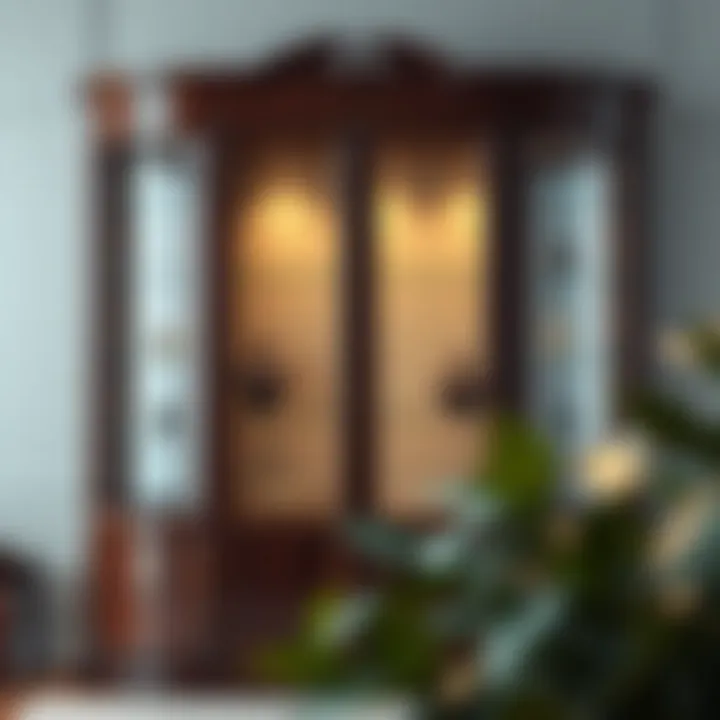Showcase Display Cases: Art of Presentation


Intro
Showcase display cases play a pivotal role in both commercial and residential settings, offering a unique way to present items while enhancing the overall aesthetic of a space. Whether in a gallery, a high-end retail store, or a cozy home, these cases do more than just hold objects; they elevate them—transforming simple pieces into focal points. Understanding the scope and significance of showcase display cases allows homeowners, interior designers, decorators, and realtors to make informed decisions about presentation and design.
These display cases have roots that stretch deep into history, evolving alongside furniture styles and consumer demands. From the ornate wooden cabinets of the Victorian era to sleek modern glass showcases, each era has brought something unique to the table. With such a rich background, the contemporary showcase display case stands as a testament to both functionality and artistry.
In this article, we’ll cover various types of showcase display cases, their design considerations, and practical applications. We’ll delve into the essential role of materials and lighting in enhancing displays, making them not only visually appealing but also functional for storing valuable items. The insights provided here offer readers a substantial understanding of how to select the right showcase display cases to meet their needs while adhering to current design trends and styles.
Understanding Showcase Display Cases
Showcase display cases are not just functional; they also serve as an artistic means to elevate the presentation of items, whether in homes, galleries, or retail spaces. Understanding these display cases involves recognizing their significance in showcasing art, artifacts, and treasured possessions. The right showcase can transform an ordinary item into an eye-catching focal point. This section will explore the basic definition and historical context of showcase display cases, allowing the readers to grasp their vital role in both art and design.
Definition and Purpose
A showcase display case is a protective enclosure that highlights and displays items for admiration. Their design typically involves transparent materials, such as glass or acrylic, which allow onlookers to see the contents without the necessity of physical contact. The primary purpose of these cases goes beyond mere protection; they are designed to present items in a way that enhances their visual appeal. For instance, a well-lit display case can draw attention towards a valuable art piece or collectibles, making them the centerpiece of a room. Moreover, they introduce an element of organization and sophistication to any space, serving as a tool for both homeowners and professionals alike in curating and managing collections.
Historical Context
Origins and Traditional Uses
The genesis of showcase display cases can be traced back to ancient civilization, where artifacts were often exhibited for worship or admiration. Initially crafted from wood and simple glass panes, these early display cases were designed more functionally, emphasizing protection rather than aesthetics. Museums and royal galleries were pioneers in using display cases to showcase collections publicly, promoting education and cultural appreciation. The presence of such cases assured that precious items were safeguarded from damage while still being accessible to the public. This longstanding tradition of display nurtured the concept of showcasing, serving as a crucial cultural tool.
- Key Characteristics of Origins and Traditional Uses:
- Functional yet simplistic designs.
- Focus on visibility combined with protection.
- Often housed in public institutions for educational purposes.
While functional, this approach sometimes lacked the finesse that is sought after in modern display cases.
Evolution in Design
With the onset of new materials and technological advances, display cases evolved from their rudimentary origins into sophisticated fixtures that not only serve practical purposes but also enhance interior design. Modern showcase display cases are designed with aesthetics in mind, utilizing materials such as tempered glass, polished aluminum, and other innovative composites that provide structural integrity and visual intrigue. Features like LED lighting, adjustable shelving, and integrated locking mechanisms have become standard, allowing for adaptability and security. This evolution signifies the shift from merely displaying objects to crafting a narrative around them.
- Unique Features of Evolution in Design:
- Sleek and modern materials.
- Enhanced lighting for dramatic effects.
- Greater customization for varied spaces and collections.
The advancements in design not only cater to visual creativity but also aim to meet the diverse needs of different environments, ensuring that these cases are as versatile as they are functional. By integrating form and function, contemporary showcase display cases serve to enhance the experience of viewing displayed items.
"A well-crafted showcase isn't just a box for your treasures; it's a window into a world of possibility, turning the ordinary into the extraordinary."
In summary, understanding showcase display cases requires appreciation of their rich history, from practical beginnings to their rise as essential elements of modern decor. The marriage of function and aesthetic design greatly contributes to their importance in various settings, making them indispensable for any connoisseur of art or valuables.
Discover more about display case history on Wikipedia and Britannica for a broader context.
Different Types of Showcase Display Cases
Understanding the different types of showcase display cases is vital for coordinating the presentation of art, collectibles, or products. Each type of case serves distinct purposes and can enhance the aesthetic of any setting. Recognizing their unique characteristics allows homeowners, interior designers, and retailers to make informed choices when selecting display solutions that meet their specific needs.
Glass Display Cases
Glass display cases are often seen as the gold standard for showcasing items. They offer clear visibility and a sense of openness, making them a favorite for galleries and retail environments alike. Here’s a closer look at a couple of important elements within this category.
Wall-Mounted vs. Freestanding
One of the significant distinctions in glass display cases is between wall-mounted and freestanding options. Wall-mounted cases are typically attached directly to a wall, providing a space-saving solution that doesn’t overcrowd the floor. This feature is particularly beneficial in smaller rooms or narrow hallways. On the flip side, freestanding cases can be placed anywhere, allowing for greater display flexibility. They often have more depth and can accommodate larger items, making them popular in showrooms where customer interaction is encouraged.
Here’s a key point: wall-mounted cases add vertical interest without consuming floor space, making them perfect for limited areas. However, they may restrict the visibility of items if not positioned ideally. Freestanding cases, while they take more space, can be viewed from multiple angles, enhancing the overall viewing experience.
Showcase Sizes and Shapes
Showcase sizes and shapes play a crucial role in design considerations. They can range from small tabletop cases for trinkets to massive arcades that display elaborate collections. Diverse shapes—like rectangular, square, or even curvilinear—can add an artistic flair. Choosing the right size and shape not only addresses functional requirements but also aligns with the interior design style of the space.
For instance, a sleek, tall case may work wonders in a modern setting, while a rounded, glass corner display could enhance a cozy nook. The uniqueness of size and shape allows for personalization in presentations, though one must be cautious of over-cluttering. An overly large case can dominate a room, while too small a case might underwhelm the displayed pieces.
Wooden Showcase Displays
Wooden showcase displays have a charm that embodies timeless craftsmanship. Their natural warmth and texture add depth and character to any room. Let's delve into some of the aspects that make wooden displays stand out.


Craftsmanship and Aesthetic Appeal
The craftsmanship involved in wooden showcase displays affects their aesthetic and durability. Handcrafted wooden cases often feature intricate details that mass-produced cases lack. This level of detailing not only signifies quality but also enhances the overall look of the displayed items.
Wood showcases serve dual purposes: they protect items while accentuating their beauty. Many homeowners choose wooden cases for their living rooms or studies, drawn by the natural hues and the durability that wood provides. However, wood may require periodic maintenance to prevent wear and tear, making it essential to consider long-term care when choosing this type of display case.
Customization Options
Customization is another significant advantage of wooden showcase displays. Many manufacturers offer an array of finishes, sizes, and designs that allow homeowners or decorators to select pieces that perfectly match their décor. Whether opting for a late-Chippendale style display or a sleek contemporary design, customization can create a coherent look in line with existing furnishings.
That said, it’s crucial to balance preferences with practicality. Customized cases often carry a higher price tag and could have longer lead times. Still, the tailored fit can transform an ordinary space into something extraordinary while ensuring that every display reflects the owner's unique taste.
Metal and Combination Showcase Cases
Metal and combination showcase cases are increasingly gaining popularity, especially in modern contexts. Their sleek appearance and versatility make them a desirable option for many environments. Let's explore what makes them tick.
Durability and Modern Design
One of the standout characteristics of metal showcase cases is their exceptional durability. Their sturdiness means they can withstand more wear and tear compared to other materials — a crucial factor in public spaces like galleries or trade shows. Additionally, their minimalist designs often align with contemporary architectural trends, blending seamlessly into modern environments.
While metal cases are incredibly durable, they can also appear cold if not integrated thoughtfully. A mixed-material approach can warm up their image, making them more inviting in settings such as homes and boutiques.
Mixed-Material Options
The trend of mixed-material showcases combines the strengths of various elements, such as metal with wood or glass. This design approach enables the creation of unique presentations that marry functionality with aesthetics. For example, a metal frame paired with wooden shelving can create a striking visual while offering robust support.
However, the downside could be the complexity of choosing materials that naturally harmonize. Balance in design will ensure that the mixed materials enhance rather than clash with each other, requiring a keen eye for detail.
In summary, understanding the myriad types of showcase display cases allows for tailored choices that meet aesthetic desires and functional necessities. Whether opting for the transparency of glass, the warmth of wood, or the robustness of metal, each type offers its unique flair while serving to elevate the art of presentation.
Design Considerations for Showcase Display Cases
When it comes to showcase display cases, design considerations play a pivotal role in determining how effectively the items on display are perceived. While the functionality of storing and protecting items is vital, blending that with aesthetics creates a compelling presentation that can captivate onlookers. Designers must engage in a detailed examination of all aspects, from intuitive usability to aesthetic appeal, ensuring every choice enhances the viewer's experience and engagement.
Functionality vs. Aesthetics
Striking the right balance between functionality and aesthetics is no small feat in the world of showcase display cases. Functionality covers the practical side, such as ensuring that items are easily accessible and secure. This often includes considerations like adjustable shelving or integrated lighting. On the other hand, aesthetics comes into play in how the case itself fits within its environment and what emotions it evokes. A display case needs to reflect the qualities of its contents while contributing to the overall theme of the room.
For example, a minimalist glass case might elevate the elegance of fine jewelry, while a rugged wooden case could underscore the earthy charm of antique collectibles. A well-thought-out approach ensures that function doesn’t overshadow form, as each aspect supports the overall presentation.
Sizing and Space Planning
Assessing Display Needs
Before diving into the specifics of design, taking stock of display needs is crucial. This involves understanding what items will be showcased and how much space they require. A standout showcase display case must cater specifically to the sizes and dimensions of the objects within.
For instance, an art gallery may require larger, more expansive cases that can accommodate paintings or sculptures, while a retail environment might opt for smaller units that showcase a variety of items. The unique aspect of this assessment lies in its adaptability; it directly contributes to maximizing visibility and interaction with the displayed items. Ignoring this could lead to either too much empty space or overcrowded shelves, neither of which enlivens the presentation.
Room Integration
Once the display needs have been identified, the next step involves seamless room integration. Think of it as fitting a puzzle piece into the bigger picture. A showcase display case must harmonize with the existing decor—colors, shapes, and texture should echo the room's overall design.
Key considerations include where the case will be placed. For instance, a case situated in a well-lit area may require fewer lighting fixtures compared to one in a dim corner. The distinctive feature of room integration is that it allows the showcase to feel like an intrinsic part of the space rather than a mere add-on. This creates an environment where not just the showcased items but the display case itself becomes a topic of conversation.
Lighting Solutions
Importance of Proper Lighting
Lighting does wonders for showcasing the right items and creating the desired ambiance. The the importance of proper lighting in showcase display cases cannot be overemphasized. It can highlight details, draw attention, and influence the mood of the displayed pieces.
Good lighting showcases textures and colors brilliantly, making items more appealing and enhancing their value in the eyes of the viewer. For instance, jewelry can twinkle brilliantly under the right spotlight, while artworks seem to come alive with well-diirected illumination. Choosing proper lighting involves a careful analysis of how it interacts with the showcase and its contents.
Types of Lighting Options
Several lighting options can be employed, each with its own benefits and limitations. Examples include:
- LED lights: These are energy-efficient and last a long time, ideal for illuminating space without generating too much heat, which can damage delicate items.
- Spotlights: An excellent choice for those who want to draw attention selectively to key items.
- Ambient lighting: Provides a soft wash of light, creating a more inviting atmosphere around the display case.
Each lighting option has its unique features. For instance, while spotlights can create dramatic effects, they might also cast shadows if not positioned correctly. Thus, the right lighting choice should align with the overall goals of the showcase—enhancing visibility while preserving the integrity of the displayed items.


"The design of a showcase display case does not merely reflect the items it holds; it tells a story to the viewer, weaving together aesthetics, functionality, and the space it inhabits."
Applications of Showcase Display Cases
Showcase display cases serve an invaluable role in various environments, each application showcasing unique benefits that not only enhance aesthetic appeal but also functionally preserve and protect items. Understanding the applications of these display cases invites homeowners, interior designers, and commercial outfits to think critically about their display objectives, along with the optimal solutions to meet those needs. Whether serving as a centerpiece in homes, a marketing tool in retail spaces, or a protector in galleries, these cases elevate the presentation of collections, making each context vital for intentional design choices.
Residential Use
Home Decor and Art Display
In residential settings, showcase display cases are not just furniture. They are an extension of personal style, offering a curated glimpse into the homeowner's identity. These cases allow for the display of cherished art pieces or selected decor items that spark joy or appreciation. The clear glass of a showcase case provides an unobtrusive boundary, allowing visitors to view the contents while maintaining a distinct separation from everyday life.
One of the key characteristics of using display cases in home decor is their versatility. They can fit into various design schemes, whether modern minimalism or rustic charm. For instance, a glass display case placed strategically in a living room can become both a talking piece and a protector of valuable art.
However, these cases do come with potential downsides. There is a need for regular cleaning to maintain clarity, and improper placement can lead to reflections that detract from the featured items. Thus, while they enhance decor, homeowners must balance aesthetics with maintenance requirements.
Organizing Keepsakes
Another aspect of residential showcase display cases is their utility in organizing keepsakes. Unlike traditional storage methods that hide special belongings out of sight, these cases offer a way to celebrate memories. Family heirlooms, trophies, and travel souvenirs can be arranged aesthetically, making it easier to reminisce and appreciate the past.
The distinctive feature of utilizing cases for keepsakes is their ability to prevent dust accumulation while keeping items visible. This makes them a practical choice for homes. Organizing keepsakes in an intentional display can also promote storytelling opportunities, drawing guests into personal histories.
Nonetheless, the emotional weight of organizing keepsakes can lead to overstuffing cases, which might diminish the overall aesthetic appeal. Homeowners might face the challenge of selecting which items to display without overwhelming the visual experience.
Commercial Environments
Retail and Showroom Solutions
In commercial settings, display cases act as silent salespeople. They are instrumental in enticing customers to take a closer look at products. Retail and showroom solutions benefit from strategically placed display cases that highlight merchandise while also maximizing space efficiency. A well-lit display case can draw the eye of a potential buyer, encouraging engagement with the product itself.
A prominent feature of display cases in retail is their ability to create an inviting atmosphere. Store owners can curate collections of items without cluttering the floor space. Instead, they guide customers' experiences through thoughtful arrangements. A glass display case can be instrumental in maintaining a clean, professional look that suggests high quality.
Yet, challenges persist, such as finding the right balance of attraction without locking items away from interaction. Customers can often feel disconnected when merchandise is not easily touchable. Thus, thoughtful placement and design are critical if retail showcases are to be effective.
Exhibition and Trade Show Displays
Trade shows are a battleground for attention, and the effective use of showcase display cases can make all the difference. These cases serve to enhance brand visibility and presentation at events, offering a polished means to present products and information. The unique feature here is their portability; many display cases are designed to be lightweight and easy to assemble, catering to the fast-paced nature of trade shows.
Moreover, showcase display cases can play a crucial role in narrative-building. They help craft a brand story through curated exhibits, fostering a connection between potential clients and the products offered. By effectively highlighting key offerings, brands can turn temporary display spaces into memorable experiences.
However, the high cost of exemplary cases can be a barrier for some exhibitors, especially small businesses. They need to assess the return on investment for such displays, meaning that proper market analysis is imperative prior to procurement.
Museum and Gallery Applications
Preservation of Artifacts
In both museums and galleries, the preservation of artifacts is of utmost importance. Showcase display cases protect sensitive materials from environmental stressors like dust, UV light, and fluctuating humidity. This specialty enhances the longevity of the displayed items, which is a top priority for curators. Museums have long trusted display cases to maintain the integrity of pieces that may be irreplaceable.
A key characteristic of these cases is their ability to control the atmosphere inside. Advanced options offer features like temperature regulation and humidity control, which are critical for sensitive historical artifacts. However, the major disadvantage is the cost of high-tech solutions which may not fit into all budgets.
Enhancing Visitor Experience
Finally, the visitor experience in museums and galleries greatly benefits from the thoughtful application of showcase display cases. They allow for unobstructed views of exhibitions while still providing information through design elements. Engaging displays can educate while also capturing attention, ultimately enhancing the overall experience.
An appealing feature of this approach is the opportunity for interactive elements—such as touch screens or QR codes—integrated into displays that engage a digital-savvy audience. However, the flip side is the risk of overwhelming visitors with intricate designs and excessive technology, which could detract from the items being presented.
In summary, the applications of showcase display cases extend from housing treasured items in homes to serving as essential tools in commercial and gallery settings. Each context requires careful consideration of design and functionality to fully appreciate the true value of these display solutions.
Selecting the Right Showcase Display Case
When it comes to showcase display cases, selecting the right one is nothing short of pivotal. A well-chosen case not only protects and displays your cherished items but also enhances their aesthetic appeal, transforming a mere presentation into a captivating experience. Proper selection ensures that your display resonates with viewers, making an impression that lasts. The correct display case addresses functional needs while complementing the overall decor, grounding its placement in the context of any space, whether personal or commercial.
Assessing Needs and Budget
Before diving headfirst into purchasing a showcase display case, it’s important to take a step back and assess your needs. What items do you intend to display? Are they large art pieces, small collectibles, or something in between? Furthermore, understanding how much you’re willing to spend plays a crucial role. Budget constraints can dictate material choices, size, and even added features that might be on your wish list.
- Size is Key: Ensure the dimensions align with both the item size and the space available in your home or business.
- Functionality Matters: Determine if you need a case that is freestanding or wall-mounted, as each provides unique placement options.


Taking time in this assessment phase can save headaches down the line.
Material Considerations
Balancing Cost and Quality
The balance between cost and quality shouldn't be overlooked. Showcase display cases can range from economical to extravagant. It's tempting to choose the cheapest option, but doing so might lead to regrets later. A well-built display case not only protects your items but also adds value to them.
- Longevity Over Savings: Investing in quality materials can mean fewer replacements and repairs in the long run.
- Aesthetics Matter: Materials like tempered glass or solid wood provide elegance and sophistication that low-cost alternatives cannot match.
The chic yet sturdy allure of a well-crafted case exemplifies why balancing cost with quality is crucial in this article.
Evaluating Maintenance Requirements
Next comes the maintenance aspect. Each material has different upkeep challenges. A clear glass case may require regular cleaning to showcase items effectively, while wooden cases might be sensitive to humidity and temperature changes.
- Glass Cases: Require careful cleaning to avoid scratches.
- Wooden Cases: Need occasional polishing to maintain their finish and integrity.
Evaluating maintenance requirements prior to purchase ensures you are prepared for the longevity of the display case, matching it with your lifestyle or business context.
Choosing the Right Features
Locking Mechanisms for Security
Security features, like locking mechanisms, are indispensable when the displayed items are of significant value—be it sentimental or financial. A quality lock deters theft and provides peace of mind.
- Added Safety: An effective locking system not only safeguards valuable items but also enhances the overall trustworthiness of the display case.
- Types of Locks: Explore different lock styles, from simple padlocks to sophisticated electronic systems.
In this article, the importance of security in a showcase display case is crystal clear, influencing both the selection process and user confidence.
Accessibility Features
Accessibility enhances user experience immensely. Whether for personal enjoyment or business, ease of access is vital. Consider features like sliding doors or hinged tops, which can make fetching items less cumbersome.
- User-Centric Design: A well-designed display case allows for seamless interaction with displayed items without compromising their safety.
- Practical Use: If you plan to frequently show or change items, accessibility becomes paramount to avoid hassle during each swap.
Incorporating accessibility features maximizes the practicality of your showcase display case, providing a user-friendly experience alongside elegance.
The right showcase display case is more than just a container; it’s a bridge between your treasured items and the world, amplifying their significance through intelligent design.
Maintenance and Care for Showcase Display Cases
When it comes to showcase display cases, maintaining their charm and utility is crucial. The care that goes into these pieces goes beyond mere aesthetics; it preserves the value and integrity of what they hold. Whether it’s that family heirloom or a precious artwork in a gallery, how we look after these showcases can mean the difference between longevity or decline.
"A well-kept display case can elevate the perceived value of its contents, making them shine brighter in the eyes of the beholder."
Cleaning Techniques
Materials-Specific Tips
Each showcase display case is crafted from different materials, and treatment varies. For instance, glass cases require a gentle touch to avoid scratches; a soft microfiber cloth along with a glass cleaner can do wonders. Wood, on the other hand, ought to be buffed with a specialized wood polish. It’s critical to read labels since some materials, like acrylic, need particular cleaners to avoid cloudiness.
A key characteristic of materials-specific tips is that they allow for a tailored approach to cleaning. This isn’t just effective but also helps in maintaining the overall appearance of the case. One advantage of wood polish, for example, is its ability to restore natural luster while providing a protective layer. However, an oversight could lead to buildup, which might reinforce grime instead of eliminating it.
Frequency of Maintenance
The frequency with which one maintains a showcase display case is a matter of context. Homes with pets or in high-traffic areas might require more regular upkeep than those in a less active environment. Generally, it is wise to schedule cleanings at least once a month.
This regularity is vital for several reasons. First, it keeps dust from accumulating, which can dull the brilliance of displayed items. Second, monthly maintenance can catch potential damages early, preventing costly repairs down the line. On the downside, over-cleaning — particularly with harsh chemicals — can damage surfaces, so knowing when to step back is just as important.
Preventing Damage
Temperature and Humidity Control
Temperature and humidity play vital roles in the preservation of displayed items within showcase cases. Wooden pieces may warp or crack if subjected to extreme fluctuations, while delicate fabrics can suffer from mold if humidity rises. To counteract these issues, maintaining a controlled environment is crucial; ideally, showcase cases should exist in spaces where temperatures remain stable between 68-72°F and humidity kept around 40-50%.
Having a dedicated, climate-controlled space might be an option for some. However, the unique feature here is the installation of hygrometers and thermostats that inform on necessary adjustments — a safeguard against neglect. Many collectors who neglect these controls end up with irreversible damage, making the upfront investment in them worthwhile.
Protective Measures for Contents
To truly protect the treasures inside display cases, one must think beyond the case itself. Using acid-free materials for backing and shelving can significantly prevent chemical reactions that would otherwise damage items. Inserted felt or foam can also minimize movement, reducing wear and tear.
A critical aspect of protective measures is that they also enhance aesthetic appeal. Utilizing unobtrusive guards can allow items to be seen clearly while keeping them safe from dust, dirt, and fingerprints. It’s a balanced act: while added layers can protect, they should not detract from the display. Opting for options that integrate seamlessly with the showcase's design is often the best course of action.
In summary, thoughtful maintenance and care are not merely routine chores; they play a pivotal role in safeguarding the presentation of items. For homeowners, interior designers, or those simply looking to enhance their display environments, understanding these principles ensures that showcase display cases shine in more ways than one.















